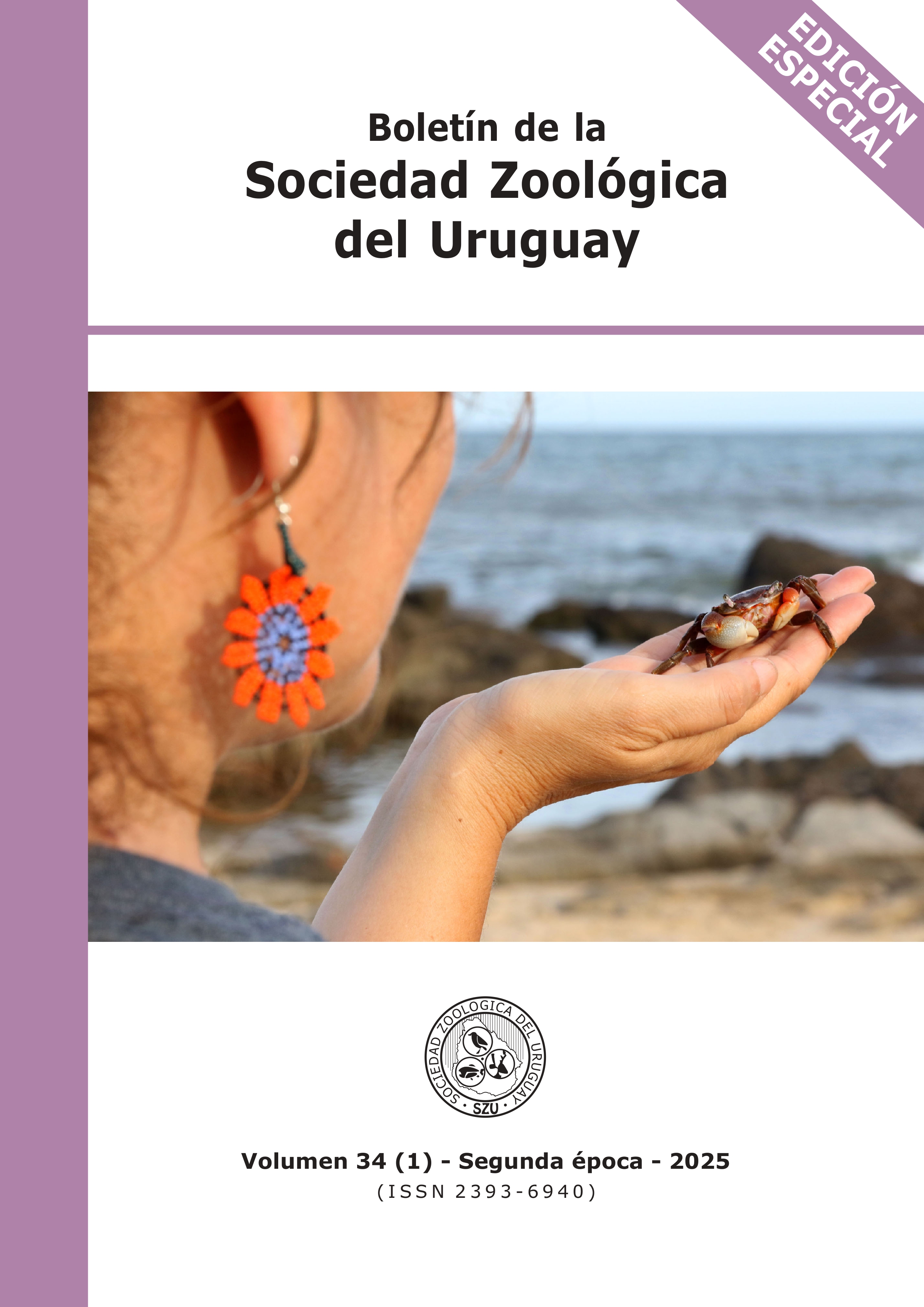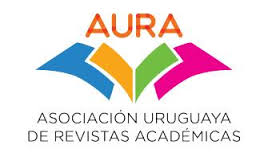EPIBIONTES ASOCIADOS A LA BASURA MARINA EN PLAYAS DE URUGUAY, POSIBLES INDICADORES DE SU ORIGEN
DOI:
https://doi.org/10.26462/34.1.15Palabras clave:
basura marina, plásticos, playas de arena, epibiontesResumen
La basura marina antropogénica ha sido reconocida como un serio problema ambiental, económico, de salud humana y estético a nivel mundial. Las playas de arena proveen una gran cantidad de servicios ecosistémicos además de recreación, y son altamente afectadas por la presencia de basura. En este trabajo se evaluó la composición de la basura marina encontrada en tres playas oceánicas de Uruguay, y se determinó su flotabilidad y la presencia/ ausencia de organismos epibiontes sobre ella. Los plásticos flotantes sin epibiontes fueron el tipo de ítem más abundante en todas las playas, la ausencia de epibiontes permitió inferir que las fuentes son principalmente locales. También se registró una pequeña proporción de plásticos flotantes con epibiontes (bivalvos, briozoos y balanos), indicando evidencia de que estos ítems permanecieron en el medio marino durante un tiempo suficiente para ser colonizados antes de ser depositados en la playa, posiblemente impulsados por las corrientes. Nuestros resultados sugieren que gran parte de la basura es de origen local. Esto podría ser una consecuencia de una deficiente gestión de residuos que se derivan de la actividad humana en la región. Por ello, se recomienda abordar el problema desde una perspectiva local de gestión y educación ambiental comunitaria.
Descargas
Citas
Cheshire, A.C., Adler, E., Barbière, J., Cohen, Y., Evans, S., … & Westphalen, G. (2009). UNEP/IOC Guidelines on Survey and Monitoring of Marine Litter. UNEP Regional Seas Reports and Studies, No. 186; IOC Technical Series No. 83: xii + 120 pp.
Chiba, S., Saito, H., Fletcher, R., Yogi, T., Kayo, M., Miyagi, S., Ogido, M., & Fujikura, K. (2018). Human footprint in the abyss: 30 year records of deep-sea plastic debris. Marine Policy, 96, 204-212.
De-la-Torre, G.E., Dioses-Salinas, D.C., Pérez-Baca, B.L., Cumpa, L.A.M., Pizarro-Ortega, C.I., Torres, F.G., ... & Santillán, L. (2021). Marine macroinvertebrates inhabiting plastic litter in Peru. Marine Pollution Bulletin, 167, 112296.
De-la-Torre, G.E., Romero Arribasplata, M.B., Lucas Roman, V.A., Póvoa, A.A., & Walker, T.R. (2023). Marine litter colonization: Methodological challenges and recommendations. Frontiers in Marine Science, 10, 1070575.
Galgani, F., Brien, A.S.O., Weis, J., Ioakeimidis, C., Schuyler, Q., Makarenko, I., ... & Bebianno, M.J. (2021). Are litter, plastic and microplastic quantities increasing in the ocean?. Microplastics and Nanoplastics, 1, 1-4.
Ghosh, S., Sinha, J.K., Ghosh, S., Vashisth, K., Han, S., & Bhaskar, R. (2023). Microplastics as an emerging threat to the global environment and human health. Sustainability, 15(14), 10821.
Gracia, A., Rangel-Buitrago, N., & Flórez, P. (2018). Beach litter and woody-debris colonizers on the Atlantico department Caribbean coastline, Colombia. Marine Pollution Bulletin, 128, 185-196.
Haram, L.E., Carlton, J.T., Centurioni, L., Choong, H., Cornwell, B., Crowley, M., ... & Ruiz, G.M. (2023). Extent and reproduction of coastal species on plastic debris in the North Pacific Subtropical Gyre. Nature Ecology & Evolution, 7(5), 687-697.
Harris, L.R., & Defeo, O. (2022). Sandy shore ecosystem services, ecological infrastructure, and bundles: New insights and perspectives, Ecosystem Services, 57, 101477.
Honorato-Zimmer, D., Kruse, K., Knickmeier, K., Weinmann, A., Hinojosa, I.A., & Thiel, M. (2019). Inter-hemispherical shoreline surveys of anthropogenic marine debris-a binational citizen science project with schoolchildren. Marine pollution bulletin, 138, 464-473.
Joppa, L.N., O'Connor, B., Visconti, P., Smith, C., Geldmann, J., Hoffmann, M., ... & Burgess, N.D. (2016). Filling in biodiversity threat gaps. Science, 352(6284), 416-418.
Kiessling, T., Gutow, L., & Thiel, M. (2015). Marine Litter as Habitat and Dispersal Vector. In Bergmann, M., Gutow, L., Klages, M. (eds) Marine Anthropogenic Litter. Springer, Cham. https://doi.org/10.1007/978-3-319-16510-3_6
Lebreton, L., van der Zwet, J., Damsteeg, J., Slat, B., Andrady, A., & Reisser, J. (2017). River plastic emissions to the world's oceans. Nature Communications 8, 15611.
Lenzi, J., Burgues, M.F., Carrizo, D., Machín, E., & Teixeira-de Mello, F. (2016). Plastic ingestion by a generalist seabird on the coast of Uruguay. Marine pollution bulletin, 107(1), 71-76.
Lozoya, J.P., De Mello, F.T., Carrizo, D., Weinstein, F., Olivera, Y., Cedrés, F., ... & Fossati, M. (2016). Plastics and microplastics on recreational beaches in Punta del Este (Uruguay): unseen critical residents?. Environmental Pollution, 218, 931-941.
Mantelatto, M.C., Póvoa, A.A., Skinner, L.F., de Araujo, F.V., & Creed, J.C. (2020). Marine litter and wood debris as habitat and vector for the range expansion of invasive corals (Tubastraea spp.). Marine Pollution Bulletin, 160, 111659.
Maxwell, S.L., Fuller, R.A., Brooks, T.M., & Watson, J.E.M. (2016). Biodiversity: the ravages of guns,
nets and bulldozers. Nature 536, 143-145.
Ocean Conservancy (2015). Stemming the tide: landbased strategies for a plastic-free ocean. Ocean
Conservancy and McKinsey Center for Business and Environment, 48pp.
ONU (2021). De la contaminación a la solución: Una evaluación global de la basura marina y la contaminación por plásticos. Naciones Unidas.
Owens, K.A., & Kamil, P.I. (2020). Adapting Coastal Collection Methods for River Assessment to Increase Data on Global Plastic Pollution: Examples From India and Indonesia. Frontiers in Environmental Science, 7, 208. doi:10.3389/fenvs.2019.00208
Pegado, T., Andrades, R., Noleto-Filho, E., Franceschini, S., Soares, M., Chelazzi, D., ... & Giarrizzo, T. (2024). Meso-and microplastic composition, distribution patterns and drivers: A snapshot of plastic pollution on Brazilian beaches. Science of The Total Environment, 907, 167769.
Poeta, G., Conti, L., Malavasi, M., Battisti, C., & Acosta, A.T.R. (2016). Beach litter occurrence in sandy littorals: The potential role of urban areas, rivers and beach users in central Italy. Estuarine, coastal and shelf science, 181, 231-237.
Rech, S. (2018). Los plásticos contaminantes marinos como vector de transporte para especies exóticas. Tesis de Doctorado en Ingeniería química, ambiental y bioalimentaria. Universidad de Oviedo, Oviedo. 143 pp.
Rech, S., Borrell, Y., & García-Vazquez, E. (2018). Anthropogenic marine litter composition in coastal areas may be a predictor of potentially invasive rafting fauna. PloS ONE. 13, e0191859. Doi: 10.1371/journal.pone.019185
Rodríguez, C., Fossatti, M., Carrizo, D., Sánchez-García, L., de Mello, F.T., Weinstein, F., & Lozoya, J.P. (2020). Mesoplastics and large microplastics along a use gradient on the Uruguay Atlantic coast: types, sources, fates, and chemical loads. Science of the Total Environment, 721, 137734.
Rumbold C.E., García G.O., & Seco Pon J.P. (2020). Fouling assemblage of marine debris collected in a temperate south-western Atlantic coastal lagoon: A first report. Marine Pollution Bulletin, 154, 111103.
Ryan, PG., Moore, C.J., van Franeker, J.A., & Moloney, C.L. (2009). Monitoring the abundance of plastic debris in the marine environment. Philosophical Transactions of the Royal Society B, 364, 1999-2012.
Scarabino, F., Sciandro, J., Vélez-Rubio, G., Burgues, F., Carrizo, D., Cedrés, F., ... & Lacerot, G.(2015). Management and research on plastic debris in Uruguayan Aquatic Systems: update and perspectives. Revista de Gestão Costeira Integrada-Journal of Integrated Coastal Zone Management, 15(3), 377-393.
Serra-Gonçalves, C., Lavers, J.L., & Bond, A.L. (2019). Global review of beach debris monitoring and future recommendations. Environmental science & technology, 53(21), 12158-12167.
Thiel, M., & Gutow, L. (2005). The ecology of rafting in the marine environment I. The floating substrata. Oceanography and Marine Biology Annual Review 42, 181-264.
UNEP (2016). Marine plastic debris and microplastics - Global lessons and research to inspire action and guide policy change. United Nations Environment Programme, Nairobi.
van Emmerik, T.H.M. (2024). The impact of floods on plastic pollution. Global Sustainability, 7, e17.
Velasco-Charpentier, C., Pizarro-Mora, F., Estrades, A., & Veléz-Rubio, G.M. (2016). Epibiontes en juveniles de tortugas carey Eretmochelys imbricata varadas en la costa del Departamento de Rocha, Uruguay. Revista de Biología Marina y Oceanografía, 51, 449-453.
Vélez-Rubio, G.M., Teryda, N., Asaroff, P.E., Estrades, A., Rodriguez, D., & Tomás, J. (2018). Differential impact of marine debris ingestión during ontogenetic dietary shift of green turtles in Uruguayan waters. Marine pollution bulletin, 127, 603-611.
Vidal, C., Lozoya, J.P., Tesitore, G., Goyenola, G., & Teixeira-de-Mello, F. (2021). Incidence of watershed land use on the consumption of meso and microplastics by fish communities in uruguayan lowland streams. Water, 13(11), 1575.
Wang, T., Li, B., Shi, H., Ding, Y., Chen, H., Yuan, F., ... & Zou, X. (2024). The processes and transport fluxes of land-based macroplastics and microplastics entering the ocean via rivers. Journal of Hazardous Materials, 133623.
Willis, K., Hardesty, D.B., Kriwoken, L., & Wilcox, C. (2017). Differentiating littering, urban runoff and marine transport as sources of marine debris in coastal and estuarine environments. Scientific reports, 7(1), 44479.











